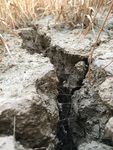University warns of long-term effects of UK heatwave
20th August 2018
Dr Nicola Cannon, Principal Lecturer in Agronomy at the Royal Agricultural University (RAU) explains why the 2018 heatwave will have long-term consequences for crops and livestock nutrition with farmers having to reach into winter reserves of food and forage:
“The extreme heat and very dry conditions are affecting agriculture in many ways and the impact of this extreme weather is going to be felt for months to come. The most important months for crop growth in the United Kingdom are May to August as temperatures, day length and weather are normally optimal for plant growth.
“Plants need light, water and nutrients for growth with carbon dioxide for photosynthesis. There has certainly been plenty of sunlight this year - and carbon dioxide is not limited in the air - but water has been scarce.
“Plants try to protect themselves from losing too much water by shutting down the guard cells which surround their stomata (pores allowing gas exchange). But as a result the plants cannot photosynthesise, as CO2 cannot then get in. If plants can’t photosynthesise they can’t grow and therefore productivity is immediately reduced.
“Some stressed cereal plants like spring barley can have almost pink straw which is thought to be a result of drought stress on the leaves during growing conditions. Many plants have been hit particularly hard by the hot dry weather whilst some deeper rooted plants have fared a bit better. Arable crops are generally being reported as about 20% down on normal yields. Many farmers with livestock on their farm are really struggling as there is insufficient grass and forage currently growing to meet their nutritional requirements.
“This has serious implications as not only is it an extra job to feed livestock now but also they are currently eating the food that was being preserved for winter feeding.
This is creating uncertainty about what livestock will eat later in the year. Not only this, but grass and other forage crops have had very limited regrowth following first silage cut meaning there is little available to take subsequent cuts to store for winter feed.
“Whilst cracked soils look very dramatic and dry there are some advantages to this process. The natural cracking can help break up compacted soils thereby increasing water infiltration and drainage in the winter as natural channels exist in the soils. Clay soils are far more prone to cracking than sand or silt and these are the very soils that suffer most of deeper compaction. Farmers often have to try and aid this process of cracking by subsoiling a field to improve drainage.
“Whilst most of the arable crops for 2018 have now completed the majority of their growing and have either already been harvested or are ripening up for harvest, fruit and vegetable growers are really suffering. Water for irrigation has almost run out and temperatures have been so high in the day that it can be difficult to apply water without damaging the plants. Harvest is earlier than usual as crops died off prematurely due to water stress. Oilseeds and grains have been harvested at very low moisture contents, and so have not required drying, but this means that farmers have lower yields to sell as there is less water retained in the crop.
“There are some crops which are better adapted to these hot dry conditions including maize and miscanthus (elephant grass used for biofuel) as they can carry on photosynthesising even in hot conditions.
“But, the challenge for UK farmers is knowing what weather is likely to occur in a season and it changes year by year. In 2017, conditions were very dry throughout April and early May which caused problems with spring sown crops but then it was particularly wet in August. This year has thrown up completely different challenges with extremely cold weather, including the ’beast from the east’ during the first few months and a very late spring.
“Many farmers could not start planting spring crops until early May and from almost this period it has been very dry and hot meaning that growth has been limited.
“It’s now time to look ahead to the 2019 harvest and the first fields of oilseed rape would normally be planted from 15 August. However, where soils are so dry it can require greater quantities of fuel and power to cultivate the soil and there is such limited moisture in the soil that any seed planted is unlikely to germinate quickly. That means it is more prone to pest problems, often has reduced vigour and uneven establishment - if it can establish at all.”






 Except where otherwise stated, content on this site is
licensed under a Creative Commons Attribution 3.0 License.
Except where otherwise stated, content on this site is
licensed under a Creative Commons Attribution 3.0 License.
